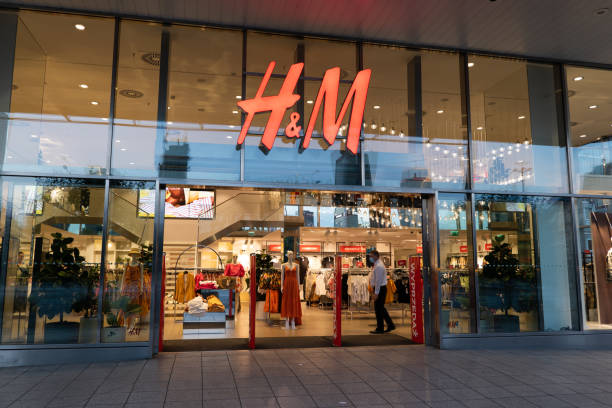In the ever-evolving world of fashion, H&M stands out as a global leader in affordable fashion. With a presence in over 70 countries and more than 5,000 stores worldwide, H&M has become a household name synonymous with stylish yet budget-friendly clothing. This article delves into the factors that have propelled H&M to the forefront of the fashion industry, including its innovative strategies, sustainability initiatives, and commitment to customer satisfaction.
A Brief History of H&M
H&M, or Hennes & Mauritz, was founded in 1947 in Västerås, Sweden, by Erling Persson. The brand initially focused on women’s clothing, but in 1968, it expanded to include menswear after acquiring Mauritz Widforss, a hunting and fishing equipment store. This acquisition marked the beginning of Hennes & Mauritz, now known as H&M. The brand’s growth was swift and steady, fueled by a commitment to offering fashion-forward clothing at affordable prices.

Innovative Business Model
Fast Fashion Pioneer
H&M’s business model is often described as fast fashion, a term that denotes the rapid production of trendy clothing to meet consumer demand. This approach allows H&M to quickly respond to the latest fashion trends, ensuring that their stores are always stocked with the most current styles. The brand’s ability to turn around new designs in a matter of weeks, rather than months, sets it apart from traditional fashion retailers.
Collaborations with High-End Designers
One of H&M’s most successful strategies has been its collaborations with high-end designers. By partnering with renowned designers like Karl Lagerfeld, Stella McCartney, and Alexander Wang, H&M has been able to offer exclusive, limited-edition collections at affordable prices. These collaborations not only generate significant media buzz but also attract a diverse customer base eager to purchase designer pieces at a fraction of the cost.
Commitment to Sustainability
H&M Conscious Collection
Sustainability is a core component of H&M’s business strategy. The brand launched its H&M Conscious Collection to promote eco-friendly fashion. This collection features clothing made from organic cotton, recycled polyester, and other sustainable materials. H&M has set ambitious goals to increase the use of sustainable materials across all its product lines.
Garment Recycling Program
In addition to offering sustainable products, H&M encourages customers to recycle their old clothing. The brand’s Garment Recycling Program allows customers to drop off unwanted textiles at any H&M store. These items are then sorted and either reused, repurposed, or recycled, reducing the amount of waste that ends up in landfills. H&M aims to close the loop in fashion by creating a circular economy where resources are continually reused.
Expanding Digital Presence
E-Commerce and Mobile App
As consumer shopping habits shift towards online platforms, H&M has made significant investments in its digital infrastructure. The brand’s e-commerce platform is user-friendly and offers a seamless shopping experience. Additionally, H&M’s mobile app provides customers with easy access to the latest collections, exclusive offers, and personalized recommendations.
Social Media Engagement
H&M leverages the power of social media to connect with its audience and promote its products. With millions of followers on platforms like Instagram, Facebook, and Twitter, H&M regularly shares fashion inspiration, behind-the-scenes content, and updates on new collections. This active social media presence helps the brand stay relevant and engaged with its customers.
Customer-Centric Approach
Diverse Product Range
H&M’s success can also be attributed to its diverse product range. The brand offers a wide variety of clothing, accessories, and footwear for men, women, and children. From casual wear to formal attire, H&M caters to different tastes and occasions, ensuring that there is something for everyone.
Affordable Pricing Strategy
One of H&M’s key selling points is its affordable pricing. By keeping costs low, the brand makes fashion accessible to a broad audience. H&M achieves this through efficient supply chain management, bulk purchasing, and cost-effective production methods. The brand’s ability to offer stylish clothing at competitive prices has earned it a loyal customer base.
Global Expansion
Strategic Store Locations
H&M’s global presence is a testament to its strategic expansion efforts. The brand carefully selects store locations in prime areas with high foot traffic, such as shopping malls and city centers. This approach ensures maximum visibility and accessibility, attracting a steady stream of customers.
Entering Emerging Markets
H&M has also been proactive in entering emerging markets with high growth potential. By establishing a presence in countries like India, China, and Brazil, H&M taps into new customer bases and expands its global footprint. These markets offer significant opportunities for growth, given their large populations and increasing consumer spending power.
Adapting to Market Trends
Sustainable Fashion Initiatives
The fashion industry is increasingly moving towards sustainability, and H&M is at the forefront of this shift. The brand has committed to becoming climate positive by 2040, which involves reducing its greenhouse gas emissions and increasing the use of renewable energy. H&M is also investing in innovative technologies, such as the development of new sustainable materials and circular production processes.
Embracing Diversity and Inclusion
H&M recognizes the importance of diversity and inclusion in today’s market. The brand has taken steps to ensure that its advertising campaigns and product offerings reflect a diverse range of body types, ethnicities, and genders. By promoting inclusivity, H&M resonates with a wider audience and fosters a sense of belonging among its customers.
Conclusion
H&M’s rise to prominence in the fashion industry can be attributed to its innovative business model, commitment to sustainability, and customer-centric approach. The brand’s ability to adapt to changing market trends and embrace new opportunities has solidified its position as a global leader in affordable fashion. As H&M continues to evolve, it remains dedicated to providing stylish, high-quality clothing at prices that everyone can afford.
FAQs
Q: What is the history of H&M?
A: H&M, or Hennes & Mauritz, was founded in 1947 in Västerås, Sweden. It started as a women’s clothing store and expanded to include menswear in 1968 after acquiring Mauritz Widforss. The brand is now a global leader in affordable fashion, with over 5,000 stores in more than 70 countries.
Q: What is H&M’s business model?
A: H&M operates on a fast fashion model, which involves the rapid production of trendy clothing to meet consumer demand. This model allows H&M to quickly respond to the latest fashion trends and keep their stores stocked with current styles.
Q: How does H&M collaborate with designers?
A: H&M partners with high-end designers to create exclusive, limited-edition collections. These collaborations with designers like Karl Lagerfeld, Stella McCartney, and Alexander Wang offer customers access to designer pieces at affordable prices.
Q: What sustainability initiatives does H&M have?
A: H&M has several sustainability initiatives, including the H&M Conscious Collection, which features eco-friendly clothing made from sustainable materials. The brand also has a Garment Recycling Program, encouraging customers to recycle their old textiles at any H&M store.
Q: How does H&M engage with customers online?
A: H&M has invested in a robust digital infrastructure, including a user-friendly e-commerce platform and a mobile app. The brand also maintains an active presence on social media platforms like Instagram, Facebook, and Twitter to connect with its audience and promote products.
Q: What kind of products does H&M offer?
A: H&M offers a wide range of products, including clothing, accessories, and footwear for men, women, and children. The brand caters to various tastes and occasions, providing everything from casual wear to formal attire.
Q: How does H&M ensure affordable pricing?
A: H&M keeps prices low through efficient supply chain management, bulk purchasing, and cost-effective production methods. This strategy makes fashion accessible to a broad audience and helps the brand maintain a loyal customer base.
Q: What is H&M’s approach to global expansion?
A: H&M strategically selects store locations in prime areas with high foot traffic and enters emerging markets with high growth potential, such as India, China, and Brazil. This approach helps H&M expand its global footprint and reach new customer bases.
Q: What steps has H&M taken towards diversity and inclusion?
A: H&M ensures that its advertising campaigns and product offerings reflect a diverse range of body types, ethnicities, and genders. The brand promotes inclusivity to resonate with a wider audience and foster a sense of belonging among its customers.
Q: What are H&M’s future sustainability goals?
A: H&M aims to become climate positive by 2040, which includes reducing greenhouse gas emissions and increasing the use of renewable energy. The brand is also investing in new sustainable materials and circular production processes to support this goal.
Keep Reading:




